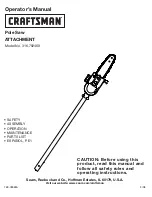
1. RAIL INSTALLATION
Unplug your table saw, lower saw blade and remove the existing fence,
including the front and rear support rails, mounting brackets and the
blade guard.
NOTE: The blade guard must be reinstalled after you have finished
mounting the Saw Train rails to your table saw.
A. Drill Rail Mounting Holes.
Remove one of the angle brackets from the extension table
hardware pack. The small hole in the top surface of bracket
will be used to accurately locate position of bolt holes for
each rail. After cleaning off front and rear apron surfaces,
place bracket to overhang saw edge and mark as shown in
Figure 1. Locate near each outside edge, front and back, of
saw table. Leave enough space for access of a ½” wrench
behind apron to tighten nut.
NOTE: If there
is no access
behind apron to attach and tighten nuts, you must
attach rails to extension wings of saw.
Center punch and drill the four holes first using a 5/32” bit as
a pilot then follow with a 5/16” drill bit (Figure 2). Place a
rectangular flat washer on each carriage bolt, insert through
holes and loosely attach the keps nuts.
B. Install Rails.
NOTE: For a custom fit of rail length to extension
tables, they may be cut off with a hacksaw, band saw or
on your table saw with a carbide-tipped saw blade.
Carefully engage carriage bolt head and washer in the large
T-slot on upper rear surface of rail. Slide forward to engage
second bolt and continue sliding to the desired position
(Figure 3). The final position will be determined by the size
of your extension table(s) and whether they will be on one or
both sides of saw.
C. Set Final Rail Position
Find the two setup gauge blocks packed with Bridge
Assembly. The gauge blocks will parallel and locate the final
rail position relative to top surface of saw. Place them on top
of rail overlapping edge of saw table as shown in Figure 4
and clamp in place. The top surface of rails should be flush
to or slightly below the bottom of the miter gauge slots.
While holding rail down so that the rabbeted end of gauge
blocks contact top surface of saw edge, securely tighten the
keps nuts with a ½” wrench. Repeat for the rear rail.
NOTE:
The gauge blocks are machined to
provide
correct rail position for most table saws. If your miter
gauge is deeper than the top surface of rails, it will be
necessary to lower both rails further by adding .020 -
.030” shims under gauge blocks.
-3-
Fig. 1
Fig. 2
Fig. 3
Fig. 4
Summary of Contents for SAW TRAIN
Page 11: ......






























